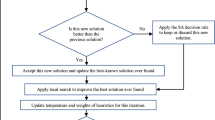Abstract
In the paper, a new method is introduced for optimally solve the problem of the layout and component size determination of sewer network. Simultaneously Layout and component size optimization of sewer network problem consists of many hydraulic constraints which are generally nonlinear and discrete; which creates a challenge even to the modern heuristic search methods. An algorithm generation of a predefined number of spanning trees is introduced to generate a predefined number of sewer layouts of a base sewer network in order of increasing length. These generated layouts are sorted in ascending order of total cumulative flow and sorted layouts are individually optimized for sewer components sizing. It has been found that the optimal sewer layout for total system optimization is one where the total cumulative flow has the minimal value. The modified particle swarm optimization (MPSO) algorithm has been used to optimally determine the component sizes of the selected layouts. The proposed method is applied to the Sudarshanpura sewer network (situated in Jaipur, India) design problem. The results are presented for optimal cost vs cumulative flow of the layouts. Further results of MPSO has been compared with the original PSO algorithm.







Similar content being viewed by others
References
Afshar MH (2006) Application of a genetic algorithm to storm sewer network optimization. Sci Iran 13:234–244
Afshar MH (2007) Partially constrained ant colony optimization algorithm for the solution of constrained optimization problems: application to storm water network design. Adv Water Resour 30:954–965
Afshar MH (2010) A parameter free continuous ant colony optimization algorithm for the optimal design of storm sewer networks: constrained and unconstrained approach. Adv Eng Softw 41:188–195
Afshar MH, Mariño MA (2006) Application of an ant algorithm for layout optimization of tree networks. Eng Optim 38:353–369
Argaman Y, Shamir U, Spivak E (1973) Design of optimal sewerage systems. J Environ Eng Div 99:703–716
Clark J, Holton DA (1995) A first look at graph theory. Allied Publishers Ltd
Dajani JS, Hasit Y (1974) Capital cost minimization of drainage networks. J Environ Eng Div 100:325–337
Deo N (2005) Graph theory with applications to engineering and computer science. Prentice Hall of India Pvt. Ltd., New Delhi
Diogo AF, Graveto VM (2006) Optimal layout of sewer systems: a deterministic versus a stochastic model. J Hydraul Eng 132:927–943
Eberhart RC, Shi Y (1998) Comparison between genetic algorithms and particle swarm optimization. In Evolutionary Programming VII. Springer Berlin Heidelberg, pp 611–616
Elimam AA, Charalambous C, Ghobrial FH (1989) Optimum design of large sewer networks. J Environ Eng 115:1171–1190
Guo Y, Walters GA, Khu ST, Keedwell E (2007) A novel cellular automata based approach to storm sewer design. Eng Optim 39:345–364
Guo YF, Walters GA, Khu ST, Keedwell EC (2008) Efficient multiobjective storm sewer design using cellular automata and genetic algorithm hybrid. J Water Resour Plan Manag 134:511–515
Haghighi A (2013) Loop-by-loop cutting algorithm to generate layouts for urban drainage systems. J Water Resour Plan Manag 139:693–703
Haghighi A, Bakhshipour AE (2012) Optimization of sewer networks using an adaptive genetic algorithm. Water Resour Manag 26:3441–3456
Izquierdo J, Montalvo I, Pérez R, Fuertes VS (2008) Design optimization of wastewater collection networks by PSO. Comput Math Appl 56:777–784
Karovic O, Mays LW (2014) Sewer system design using simulated annealing in excel. Water Resour Manag 28:4551–4565
Kennedy J, Eberhart R (1995) Particle swarm optimization. IEEE International Conference on Neural Networks (Perth, Australia), IEEE Service Center, Piscataway, NJ, IV. pp 1942–1948
Kulkarni VS, Khanna P (1985) Pumped wastewater collection systems optimization. J Environ Eng 111:589–601
Li G, Matthew RGS (1990) New approach for optimization of urban drainage systems. J Environ Eng 116:927–944
Moeini R, Afshar MH (2012) Layout and size optimization of sanitary sewer network using intelligent ants. Adv Eng Softw 51:49–62
Ostadrahimi L, Mariño MA, Afshar A (2012) Multi-reservoir operation rules: Multi-swarm PSO-based optimization approach. Water Resour Manag 26:407–427
Pan T-C, Kao J-J (2009) GA-QP model to optimize sewer system design. J Environ Eng 135:17–24
Price RK (1978) Design of storm water sewers for minimum construction cost. 1st International Conference on Urban Strom Drainage. Southampton, United Kingdom, pp 636–647
Saatci A (1990) Velocity and depth of flow calculations in partially filled pipes. J Environ Eng 116:1202–1208
Schedule of Rates (2013) Rajasthan Urban Infrastructure Development Project (RUIDP), Government of Rajasthan
Shi Y, Eberhart R (1998) A modified particle swarm optimizer. IEEE International Conference on Evolutionary Computation. IEEE, Anchorage, AK, pp 69–73
Steele JC, Mahoney K, Karovic O, Mays LW (2016) Heuristic optimization model for the optimal layout and pipe design of sewer systems. Water Resour Manag 30:1605–1620
Swamee PK (2001) Design of sewer line. J Environ Eng 127:776–781
Tekeli S, Belkaya H (1986) Computerized layout generation for sanitary sewers. J Water Resour Plan Manag 112:500–515
Walsh S, Brown LC (1973) Least cost method for sewer design. J Environ Eng Div 99:333–345
Walters GA, Lohbeck T (1993) Optimal layout of tree networks using genetic algorithms. Eng Optim 22:27–48
Walters GA, Smith DK (1995) Evolutionary design algorithm for optimal layout of tree networks. Eng Optim 24:261–281
Walters GA, Templeman AB (1979) Non-optimal dynamic programming algorithms in the design of minimum cost drainage systems. Eng Optim 4:139–148
Author information
Authors and Affiliations
Corresponding author
Rights and permissions
About this article
Cite this article
Navin, P.K., Mathur, Y.P. Layout and Component Size Optimization of Sewer Network Using Spanning Tree and Modified PSO Algorithm. Water Resour Manage 30, 3627–3643 (2016). https://doi.org/10.1007/s11269-016-1378-7
Received:
Accepted:
Published:
Issue Date:
DOI: https://doi.org/10.1007/s11269-016-1378-7




